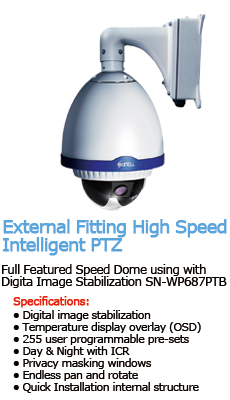High-speed domes or PTZ cameras describe cameras which can pan, tilt and zoom by refocusing lenses. According to their moving speed, the cameras are usually divided into three categories: high-speed PTZ, uniform-speed PTZ and low-speed PTZ.
Sunell describes how high-speed PTZ domes work in physical security.
High-speed domes or PTZ cameras describe cameras which can pan, tilt and zoom by refocusing lenses. According to their moving speed, the cameras are usually divided into three categories: high-speed PTZ, uniform-speed PTZ and low-speed PTZ.
1. Preset
Users often need to monitor important locations, such as doors or windows. Saving the camera's position and zoom magnification at a specific location is called a preset. After setting presets, users only need to enter the preset's number to the PTZ camera from a keyboard for the cameras to rapidly reach the preset location. Speeds are generally 200 degrees per second or more.
2. Cruising and Scanning
 PTZ cameras can automatically cruise between several preset positions for a “tour.” They can also scan between two points, along a line or in another mode.
PTZ cameras can automatically cruise between several preset positions for a “tour.” They can also scan between two points, along a line or in another mode.
3. Clear Image
PTZ images should be clearly visible. Color saturation should be as close to the actual scene as possible.
4. Privacy Masking
Surveillance cameras must protect the privacy of citizens, such as residential homes along a public street. These locations requires programmable privacy zones to respect citizen privacy. Setting this function for static cameras is easy. However, PTZ cameras operate in a 3-D world, requiring the camera to have programmable setting, based on both positioning and zoom magnification.
5. Environmental Considerations
PTZ cameras are installed indoors or outdoors, requiring different mounting options. Waterproof IP54 or IP66 protection may be required. The camera must also work in high and low temperatures. Outdoor cameras must have lightning strike resistance. Cameras in windy environment should have antijitter image correction, or image stabilization.
6. Easy Maintenance
Dome cameras must be easy to install, allowing quick removal of internal parts. Once installed, remote upgrades should be supported, so there is no need for users to remove the device. Network domes should also support soft address function for RS-485 addresses. The need to modify DIP switch position and address functions should be accessible through a simple menu interface, saving installation time.
7. Infrared
For extremely dark environment, IR PTZ cameras are needed. There are two types of IR: Active infrared and passive infrared. Active infrared technology uses IR LEDs to illuminate objects. This has several drawbacks, including a halo effect in the image quality and limited viewing distance. IR LEDs consume high amounts of power and produce too much heat.
Passive infrared technology effectively overcomes the shortcomings of active infrared technology by sensing the infrared radiation of objects. However, it is expensive. Only customers with mission-critical applications can afford it, such as military users.
IP video surveillance is an industry trend. Thanks to the power of IP, network PTZ cameras will offer users some revolutionary features:
1. High Definition
Traditional analog PTZs output CVBS video signals, limiting image resolution to 720 x 576 (PAL) or 720 x 480 (NTSC). However, network PTZ cameras encode digital signals from image sensor, which do not limit resolution It supports high-definition resolution from 1280 x 720 and 1920 x 1080. HD PTZ cameras will give broader and clearer views to users.
2. 3-D Positioning
Through IP, network PTZ cameras are easier to control. Beside a traditional keyboard, using a mouse is a better way to control PTZ functionality. If the PTZ camera supports 3-D positioning, users can just click on images through a PC for the PTZ camera to focus on that region.
3. Wireless
Wireless IP network technologies, such as Wi-Max, Wi-Fi and 3-G, enables PTZ cameras to be installed anywhere. This eliminates the distance bottleneck, as users can upload live images from anywhere.
4. Intelligence
A smart PTZ embedded with intelligent analysis, such as object extraction and recognition, can tracking objects automatically or trigger alarms. High-level application can deploy several smart PTZs to work together in monitoring large areas. Once a camera detects something unusual, it can notify another camera to track the object.